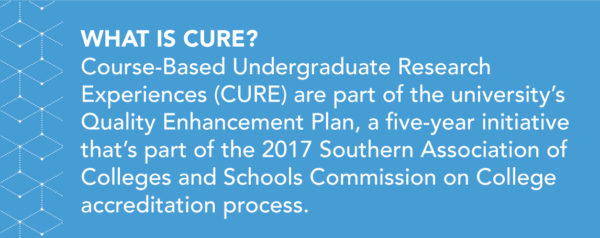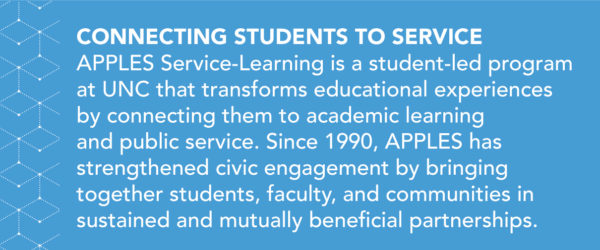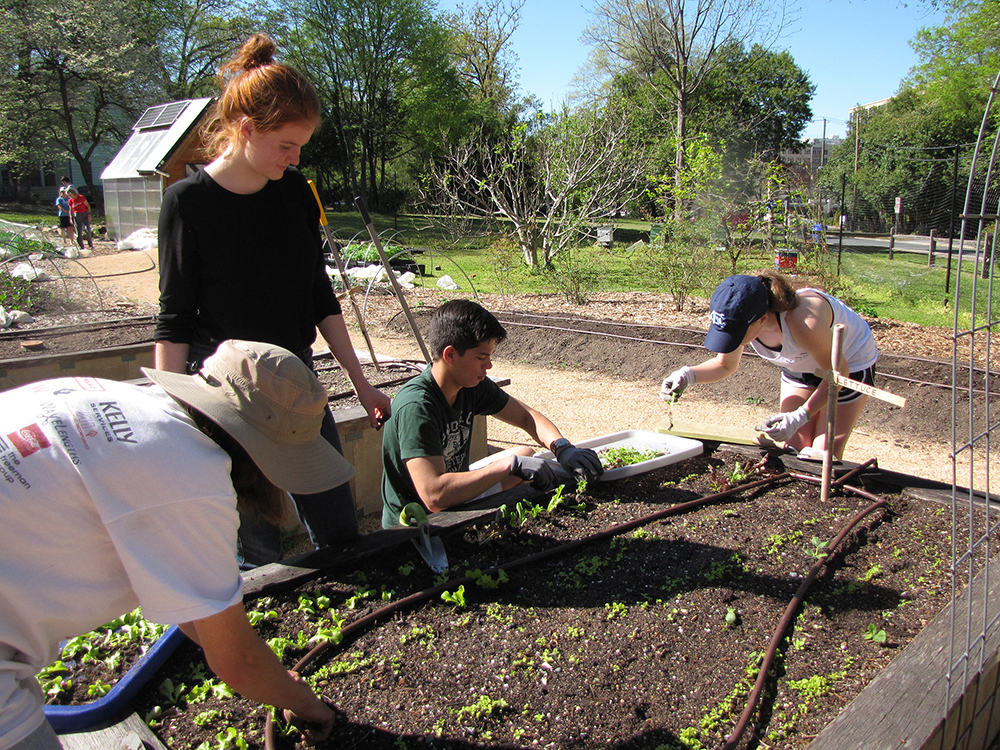Madeline Cooke squats in the dirt and leans over the stacked, wooden two-by-fours supporting a raised garden. Scissors at the ready, she trims away weeds and checks the health of rows of red-stemmed succulents. Although many might consider this jade-like plant — called purslane — a weed, it’s actually edible, often found in Asian soups, salads, and stews. And it’s packed with antioxidants.
 Cooke, a UNC senior majoring in chemistry, spent six months last year helping organic chemistry professor Nita Eskew tend to these weedy plants so she could use them in her “Chemistry of Purslane” class. A Course-Based Undergraduate Research Experience (CURE), the class provides many students with their first active research experience.
Cooke, a UNC senior majoring in chemistry, spent six months last year helping organic chemistry professor Nita Eskew tend to these weedy plants so she could use them in her “Chemistry of Purslane” class. A Course-Based Undergraduate Research Experience (CURE), the class provides many students with their first active research experience.
“Some students don’t have the opportunity to do undergraduate research while they’re here, so this gives them the experience while also getting course credit,” Eskew explains. “I also wanted to get some type of chemistry research going in an undergrad lab course so students would have some purpose in their experiment other than making crystals and throwing them in the waste jar and walking out.”
Organic chemistry can be a little obscure, admits Eskew, so a course that highlights real-world applications draws more student attention. “It’s helpful to have something more concrete you can put your hands on,” says Eskew, adding that the class had so many applicants she couldn’t accept them all.
Purslane’s antioxidant content suggests it has medicinal properties — but it’s largely understudied in the United States. Eskew hopes that she and her students can answer some basic questions about it. What are the main differences between the gold and red varieties? Does one have a higher antioxidant concentration than the other? Does the growing environment impact their chemical composition?
Encouraging curiosity
Throughout the class, which first began in Spring 2017, Eskew teaches standard chemistry techniques like extraction and ultraviolet-visible spectroscopy for identifying antioxidants in plants. Although every student learns how to perform these procedures, Eskew encourages each individual group to cultivate their own sets of questions and experiments.
“It’s about not having a recipe,” Eskew points out. “It’s about developing questions and going through the process of testing and modifying. And it’s also about iteration.”
In a traditional chemistry lab, students will complete one experiment and then move onto a different one in the following lab. But in this class, they’ll continue to run the same experiments three times or more, tweaking them each week. “In research, you don’t just do an experiment one time — you do it multiple times to try to improve it and see if you can reproduce results.”
To test the purslane for antioxidants, students perform a procedure involving a color shift that indicates when antioxidants are present. “Students can actually visualize what’s happening when the electrons are moving because they see a physical change in color,” Eskew says. “It makes the chemistry of it all more real.”
“The first time my team completed the test we were really excited — because the procedure worked,” Cooke explains. “It felt very gratifying and ebullient, and I think a lot of my group members shared that energy.”
Growing together
Before she developed the class, Eskew had never heard of purslane — until Claire Lorch pointed it out on a tour of the Carolina Campus Community Garden (CCCG), a program of the North Carolina Botanical Garden located on Wilson Street that donates all its produce to university housekeepers. Lorch, the CCCG program manager, solicits volunteers from across campus and the greater community to work in the garden year-round.
“I learned of purslane when my dear friend Vimala (of Vimala’s Curry Blossom Cafe) pointed out the plant and its nutritional value,” Lorch explains. “From then on we stopped weeding it and started planting it. Forty percent of the housekeepers are refugees from Burma and appreciate that we have purslane in the garden.”
 Eskew’s partnership with the CCCG for the class means that it’s also one of the Carolina Center for Public Service’s APPLES courses, which connect academic learning with community service. Students enrolled in the course, held once a week, must spend a minimum of 30 hours volunteering in the garden — some of which is used for lab time.
Eskew’s partnership with the CCCG for the class means that it’s also one of the Carolina Center for Public Service’s APPLES courses, which connect academic learning with community service. Students enrolled in the course, held once a week, must spend a minimum of 30 hours volunteering in the garden — some of which is used for lab time.
Since completing the class last spring, Cooke, now Eskew’s teaching assistant, continues to dedicate her time to the garden each Sunday. “It’s a unique experience in that it’s inter-generational,” she says. “On campus, I don’t get the opportunity to interact with people who are in different stages of their life, but community members and grad students come to the garden. Gardening is a lot of work with your hands so there’s plenty of time to chat.”
Inspiring others
During her own undergraduate career at Carolina, Eskew — a first-generation college student — never knew about research opportunities until her adviser suggested she pursue it one summer. She didn’t have any family or friends who were chemists, nor did she understand what chemists did outside the academic environment. This meant graduate school wasn’t originally in the cards for her either, Eskew admits, but that same adviser encouraged her to apply.
“By the end of that summer doing research, I was hooked with discovery and learning something new — and realizing that other people had never made the compounds I did or seen their reactions,” she says. “That’s why I think this class is a great opportunity to give students a small introduction into what research is, especially for those who are first-generation or have never been exposed to research.”
“Dr. Eskew is a really special person here at Carolina,” Cooke adds. “It’s admirable that she put so much time into creating this class, and how dedicated she is to her students. I think getting research experience is one of the most important things during your undergraduate career. It’s changed the way I think. To be put in a setting where no one in the room really knows the answer — and it’s okay to not know the answer — that’s great.”


